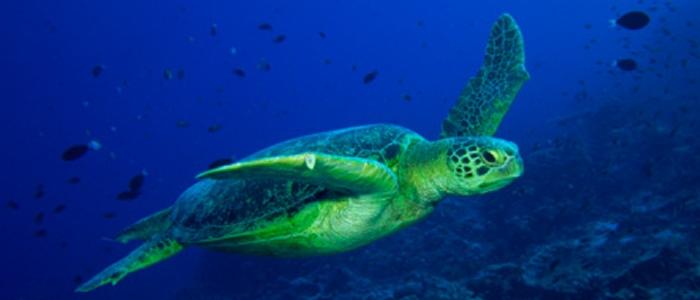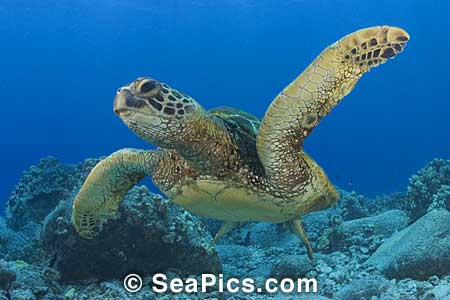
Nutrition
Chelonia mydas is generally vegetarian except during its first year of life when it is carnivorous (Bustard, 1972). Chelonia mydas will feed on jellyfish, mollusks, crustaceans, and other invertebrates until they reach 20-25 cm in length and 20-25 grams in mass (Lemm, 2006).
Once past the juvenile stage, their diet is consists of primarily angiosperms and marine algae. They also take advantage of any animal food that is readily available and have been known to eat jellyfish as adults (Bustard, 1972).
 Due to their diet, Chelonia mydas resides in shallow, warm areas where
algae and other marine vegetation are abundant (Bustard, 1972).
The tongue of the green turtle is firmly anchored to the bottom of its
mouth (Alderton, 1988). Because of this,
Chelonia mydas depend greatly on
their serrated jaw to latch onto plants and other food sources, and
pushing away the excess to tear pieces of food (Alderton,
1988). Using their
muscular tongue, green turtles direct the food into the gullet. The food
then travels into an elongated digestive tract that can reach lengths
seven times that of the length of the individuals' carapace (Alderton,
1988).
The tract is so long to accommodate the large quantities of plant fibers
being ingested by the individual (Alderton,
1988).
Due to their diet, Chelonia mydas resides in shallow, warm areas where
algae and other marine vegetation are abundant (Bustard, 1972).
The tongue of the green turtle is firmly anchored to the bottom of its
mouth (Alderton, 1988). Because of this,
Chelonia mydas depend greatly on
their serrated jaw to latch onto plants and other food sources, and
pushing away the excess to tear pieces of food (Alderton,
1988). Using their
muscular tongue, green turtles direct the food into the gullet. The food
then travels into an elongated digestive tract that can reach lengths
seven times that of the length of the individuals' carapace (Alderton,
1988).
The tract is so long to accommodate the large quantities of plant fibers
being ingested by the individual (Alderton,
1988).
The sense of smell is extremely important to this species of sea turtle. Chelonia mydas utilize both their nose as well as a structure called Jacobsen's organ (Alderton, 1988). This organ is located in the roof of the individual's mouth and is connected directly to the brain (Alderton, 1988). Jacobsen's organ functions to detect scent particles within the air or water (Alderton, 1988).
<< Habitat Home Reproduction >>